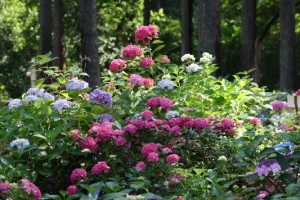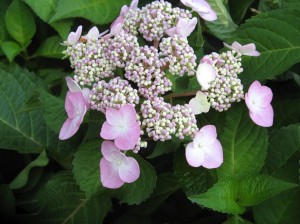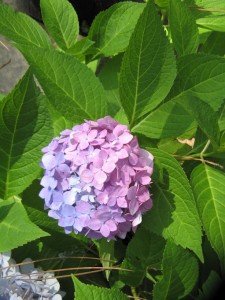
Bigleaf Hydrangea (Hydrangea macrophylla) are familiar faces in the southern shade garden. Although not originally from North America, they were introduced here over 200 years ago and perform well in the climate of the Florida Panhandle. Here are some quick tips about Bigleaf Hydranges.
- Hydrangeas prefer morning sun with afternoon shade or full shade and well-drained, moist soil
- The form is a mounding shrub that can have varying heights and widths, allow for a mature size on average of 6′ x 6′
- Hydrangeas have large green leaves that may be glossy or dull and are deciduous unless the winter is very mild
- There are two main flower types:mophead and lacecap
- Mophead flowers are rounded and usually composed of sterile flowers, with a few fertile flowers
- Lacecap flowers have sterile flowers on the outer edge of the circle, with fertile flowers in the center. When fertile flowers are fertilized they may turn a different color and the sterile flowers on the outer edge may invert themselves so they appear to be hanging down
- Flowers may be white, pink, purple, or blue; flower color is influenced by soil conditions and you may see multiple colors on the same plant!
- Bigleaf hydrangeas generally bloom on old wood, however, there are some types that will also bloom on new wood and fall into either “free-flowering” or “everblooming” categories. Free-flowering have flower buds on the tips of branches (old wood) and develop flower buds up and down the stem that flower after terminal (tip) buds flower. Everblooming hydrangeas form flower buds on the tips of both old wood and new wood and can flower throughout the season.
- If soils are sandy and infertile, add organic matter before planting
- Water as needed, especially during establishment phase (typically first year or two). Expect hydrangeas to wilt during hot summer afternoons, as with any plant check the soil moisture before irrigating to avoid overwatering
- Avoid overhead irrigation, leaf spot diseases and powdery mildew are more prevalent when foliage is wet for extended periods
- Prune after flowering, but before August when shaping is neededFor more information about long flowering hydrangea varieties see “New Hydrangeas for North and Central Florida: Bigleaf and Mountain Hydrangeas”
To learn more about influencing flower color and general care of hydrangeas read “French Hydrangea for Gardens in North and Central Florida.”
 0
0


